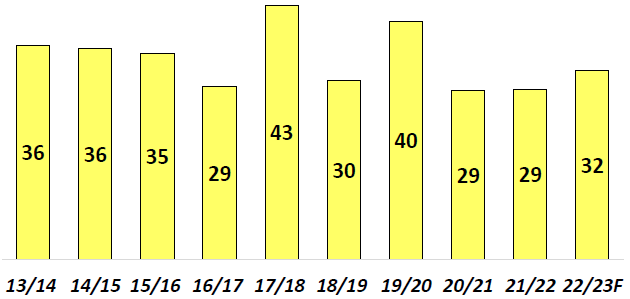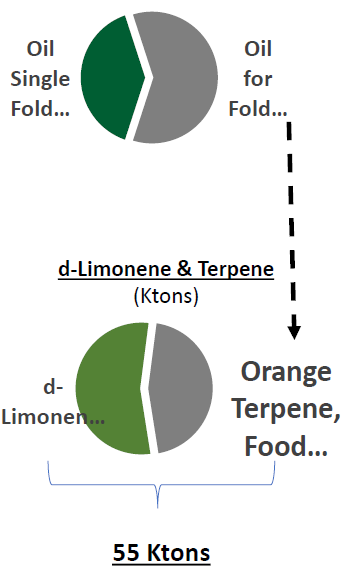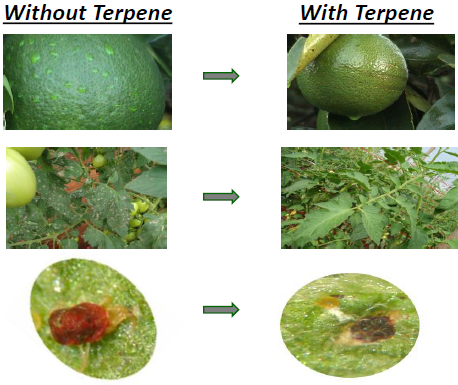Knowde Enhanced TDS
Identification & Functionality
- Chemical Family
- Flavor Family
- Fragrance
- Fragrance Family
- Fragrance Ingredient Class
- INCI Name
- Agrochemical Functions
- Base Chemicals Functions
- Cleaning Ingredients Functions
- Cosmetic Ingredients Functions
- Food Ingredients Functions
- Technologies
- Product Families
- Product Details
Botanical Specie Citrus sinensis (L.) Osbeck
Variety A blend of major Brazilian varieties. Hamlin,
Pera Rio, Valencia and NatalColor Colorless to pale yellow Season of crop (Harvesting period) May to December
Region Brazilian Citrus Belt Key GC molecules a-pinene, sabinene, myrcene, octanal, limonene, decanal and linalool Technology Citrus terpenes distilled from orange peel and pomace press liquor emulsion
Features & Benefits
- Benefit Claims
- Labeling Claims
- HII Features
- Key Benefits
- Citrus ingredient of multiple usage, source of d-Limonene, distilled raw-material to use in chemical industry
- Safe for use in food, drinks or other consumer products
- Neutral taste
- Good solvency power
- Plant based
- Health Benefits
- Reducing oxidative stress
- Reducing the risk of diabetes
- Reducing the risk of cancer
- Reducing inflammation
- Protecting the heart
- Protecting the gastrointestinal system
- Protecting the liver
- Regulating the immune system
- d-Limonene as Natural Insecticide and Herbicide
Benefits of insecticide that contains Terpene:
- Biodegradable
- Friendly to the Environment
- Breaks surface tension
- Desiccant effect on bugs
- Large volumes available
- Non-toxic to workers
- Marketing appealing
- Active ingredient effect
- Adjuvant effect
- Penetrates on the plant layer
- Mix well with other products
- Smells good
- Multi-application
- Already being commercialized
- Product Highlights
- D limonene ((R) limonene) is one of the monoterpenes most commonly found in plants The D limonene content is particularly high in many citrus peel oils and the main component of orange oil.
- As the main fragrance of citrus peels, D limonene is used in food manufacturing and some medicines, such as a flavoring to mask the bitter taste of alkaloids, and as a fragrance in perfumery, aftershave lotions, bath products, and other personal care products. D Limonene is also used as a botanical insecticide.
- D limonene is a chemical compound that naturally occurs in the peel of citrus fruits, such as oranges or lemons. It belongs to a family of chemicals known as terpenes . People can purchase d limonene as a dietary supplement. Companies also use it to give foods and beverages a citrus flavor
- Limonene is a naturally occurring chemical which is used in many food products, soaps and perfumes for its lemon like flavor and odor. Limonene also is a registered active ingredient in 15 pesticide products used as insecticides, insect repellents, and dog and cat repellents.
- Pesticide products containing limonene are used for flea and tick control on pets, as an insecticide spray, an outdoor dog and cat repellent, a fly repellent tablecloth, a mosquito larvicide, and an insect repellent for use on humans.
- Formulations include ready to use solutions, emulsifiable concentrates, granular and impregnated material. Limonene is applied by hand as needed, both indoors and outdoors.
- Use practice limitations include a label prohibition against use on weanling kittens and a caution against use of undiluted product.
- Limonene is common as a dietary supplement and as a fragrance ingredient for cosmetics products As the main fragrance of citrus peels, D limonene is used in food manufacturing and some medicines, such as a flavoring to mask the bitter taste of alkaloids , and as a fragrance in perfumery , aftershave lotions, bath products, and other personal care products
- D Limonene is also used as a botanical insecticide D Limonene is used in the organic herbicide, Avenger .It is added to cleaning products, such as hand cleansers to give a lemon or orange fragrance (see orange oil ) and for its ability to dissolve oils .In contrast, L limonene has a piny turpentine like odor.
- Limonene is used as a solvent for cleaning purposes, such as adhesive remover , or the removal of oil from machine parts, as it is produced from a renewable source (citrus essential oil, as a byproduct of orange juice manufacture ). It is used as a paint stripper and is also useful as a fragrant alternative to turpentine. Limonene is also used as a solvent in some model airplane glues and as a constituent in some paints. Commercial air fresheners, with air propellants, containing limonene are used by stamp collectors to remove self adhesive postage stamps from envelope paper
- Limonene is also used as a solvent for fused filament fabrication based 3D printing Printers can print the plastic of choice for the model, but erect supports and binders from High Impact Polystyrene (HIPS), a polystyrene plastic that is easily soluble in limonene.
- In preparing tissues for histology or histopathology, D limonene is often used as a less toxic substitute for xylene when clearing dehydrated specimens. Clearing agents are liquids miscible with alcohols (such as ethanol or isopropanol ) and with melted paraffin wax , in which specimens are embedded to facilitate cutting of thin sections for microscopy It is also combustible and has been considered as a biofuel
- Valencene is a sesquiterpene that gets its name from the place it’s most commonly found in Valencia oranges. Its citrusy, sweet aromas and flavors can be reminiscent of oranges, grapefruits, tangerines, and occasionally of fresh herbs or freshly cut wood.
- The fragrant terpene is responsible for familiar citrus aromas frequently found in a wide variety of cannabis strains. It is also a known repellent of ticks and mosquitos.
- The potential medical benefits of valencene are still being researched, but there is evidence that it may produce the following effects:
- Anti inflammatory
- Insectifugal
- Cannabis strains that can test relatively high in valencene include such citrus forward strains as Tangie and Agent Orange
Applications & Uses
- Applications
- Applicable Processes
- Base Chemicals End Uses
- Bath & Shower Applications
- Fragrances & Perfume Applications
- Home Care Applications
- I&I Cleaning Applications
- Personal Hygiene Applications
- Skin Care Applications
Properties
- Physical Form
- Odor
- Strong citrus odor
- Appearance
- Clear liquid
- Specifications
| Value | Units | Test Method / Conditions | |
| Aldehyde Content | 0.20 - 1.20 | % | USP |
| Specific Weight (at 25/25°C) | 0.839 - 0.850 | — | EOA Densimeter |
| Limonene Content | 92 - 96 | Area % | GC-FID |
| Refractive Index (at 20˚C) | 1.4700 - 1.4750 | — | EOA Refractometer |
Regulatory & Compliance
- Certifications & Compliance
- Grade
Technical Details & Test Data
- Working Procedure
- D Limonene is a fragrance, degreaser and gentle but powerful cleaner that is considered effective in removing stains, grease, tar and other substances and is a natural replacement for the more common solvents that typically contain chlorine or oil.
- Because of its softness, it has become a popular ingredient in waterless hand soaps, which say it not only cleans but also leaves hands fresh. When applied to various types of hard surfaces such as boards, windows, mirrors, floors, bathtubs, refrigerators, automobiles, and electronics, d Limonene is considered a polisher.
- Global Availability of d Limonene & Terpene
- The global annual production of d-Limonene (Citrus Terpene technical grade) is roughly 30 ktons .
- Brazil is the largest producer of d-Limonene and accounts for about 70% global share.
- When orange oils is concentrated (folded), Orange Terpene is produced.
- It is estimated that 25 ktons of Orange Terpene (food grade) is produced annually.
- Total availability of d-Limonene (Citrus Terpene) and Orange Terpene is around 55 ktons
Estimated Global Production of d Limonene, Technical Grade (Ktons)
Utilization of 50Ktons of Orange Oil
- Application Example
- Desiccant effect on bugs
- Kills on contact

Packaging & Availability
- Packaging Information
- For Drums: Steel drum with fixed cover and 02 tamper evident seals.
- Net Weight: 173 ± 1.5Kg per drum.
- For Bulk: Stainless steel container.
- Other packaging sizes available upon request.
Storage & Handling
- Shelf Life
- 24 Months
- Storage Information
- For drums: The drums must be stored at room temperature and protected from direct sunlight and excessive heat.
- For bulk: In room temperature protected from direct sunlight and excessive heat.
- Shelf Life: 24 months, provided the storage conditions have been respected.

